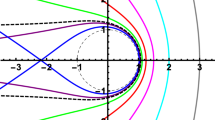Abstract
The Alcubierre Warp Drive Metric, wherein a spacecraft can appear to vastly exceed the speed of light without locally ever doing so, derived in [1], is reconsidered. It is shown that the underlying driving physical mechanism (at least in a mathematical sense) is not the expansion/contraction of the space surrounding the spacecraft via the York Time T [2]. Rather, the driving mechanism is a boost that serves as a multiplier of the ship's initial velocity. This effect can in principle be likened to watching a movie in fast-forward. The expansion/contraction of space is merely a side effect of the warp drive's underlying mechanism - that can be viewed as sort of a Doppler effect, or stress/strain on space.
Similar content being viewed by others
References
Alcubierre, M. (1994). Class. Quant. Grav. 11, L73.
Ciufolini, I. and Wheeler, J. A. (1995). Gravitation and Inertia, Princeton University Press, Princeton, New Jersey.
Pfenning, M. J. and Ford, L. H. (1997). Class. Quant. Grav. 14, 1743.
Rindler, W. (2001). Relativity, Oxford University Press, New York.
Author information
Authors and Affiliations
Rights and permissions
About this article
Cite this article
White, H.G. A Discussion of Space-Time Metric Engineering. General Relativity and Gravitation 35, 2025–2033 (2003). https://doi.org/10.1023/A:1026247026218
Issue Date:
DOI: https://doi.org/10.1023/A:1026247026218




